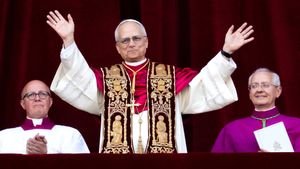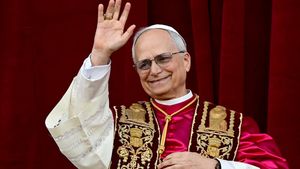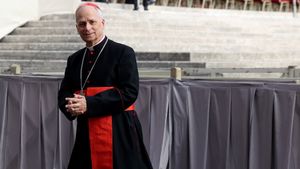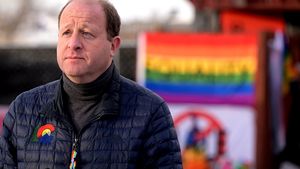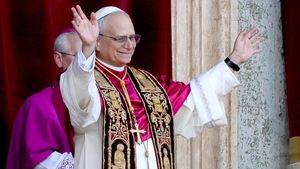Is the green fog tint throughout Guy Maddin's new film The Green Fog anything like the secretly gay meaning of the 19th century symbol of the green carnation associated with Oscar Wilde? Maddin's film seems to operate on a special, cult-based code that some viewers might find similar to the boutonnieres that, over a hundred years ago, Wilde urged friends to wear in their lapels to recognize each other as parts of a fraternity of shared interests and affections--for theater, for art, for imagination, for the homosexuality that back then was called an "inverted" (queer) way of life.
In the case of The Green Fog, Maddin, a long-time specialist in esoteric revisions of movie history, looks at San Francisco, America's most iconic gay mecca, as the city has been presented in mainstream (straight) popular culture. That green tint shows what obsessive movie lovers have in common with the gay perspective that turns art into campy cultural re-interpretation--it's half self-deprecation and half self-defense.
Related | How Mona Lisa Outed the Lesbian Archetype and Broke the Enigma Code
Maddin uses Alfred Hitchcock's 1958 Frisco-based perverse love story Vertigo (in which James Stewart makes-over Kim Novak into his erotic ideal) to locate ideas about art, transition, time and sex. The city by the bay, old movies and '70s-era television shows are all treated as myths via randomly connected clips (from The Maltese Falcon to High Anxiety and Basic Instinct) that roughly follow Vertigo's plot.
Detached from their original narrative sources, the meanings of the clips change: Vertigo collides with ABC's "The Streets of San Francisco," Mark Robson's Daddy's Gone A-Hunting interrupts Philip Kaufman's Invasion of the Body Snatchers. This dreamlike, Surrealist deconstruction of our collective movie memory parallels the transitioning of culture this millennium when ideas of gender, history and politics go through a mash-up. It re-orders--or transgresses against--previously-held definitions and morality.
The Green Fog is not actually a documentary, any more than it is a weather report of the Bay Area's famous atmospheric conditions. But Maddin's experiment, co-directed with his new collaborators Evan Johnson and Galen Johnson, uncannily matches in the way in which the moist sentimentality of time and fashion obscures the way we look at history. The filmmakers give in to the gay sexual subtext of movies that gallery artist Christian Marclay did not in his celebrated, neutral, 24-hour film montage The Clock. Many of these clips edit-out dialogue so that the "story" comes through in stuttered, hiccupy, frustrated expressions of familiar and obscure faces. The cast-of-hundreds actors, from mostly unrelated plots, simulate our contemporary social and political chaos.
But The Green Fog's most famous face is neither Stewart nor Novak, but Rock Hudson who appears in frequent snippets from his '70s TV detective show McMillan and Wife. That prime time riff on Hollywood's The Thin Man series revived Hudson's career in the year just before he succumbed to gay rumors and AIDS.
Hudson's tragedy creates a subliminal narrative for The Green Fog, largely through Maddin's persistent reminders of Hudson's TV fate, not the glory of his Hollywood films in which even his closeted masculinity now takes on a complex richness--ambiguous without ever lessening his cultural impact and historic significance. Hudson himself is like a green carnation, letting informed audiences know about the adaptability of gay identity. Like today's Jon Hamm, Hudson's imposing, often stolid presence was unleashed in his comedies (especially those co-starring Doris Day) and on McMillan and Wife he was, unlike Hamm's Mad Men character, agreeably relaxed. But the high points of Hudson's career--Giant, Something of Value, Written on the Wind--are unique testaments to movie stardom. In those films he displays a moral and erotic virtuosity, standing for what used to be our culture's highest ideals.
Maddin's film obscures Hudson's triumph and sympathy. This is partly related to movies now being overwhelmed by the frowsy standards of television and Internet culture. Cineastes might feel this omission as a personal affront, due to the undeniable cultural shift in which even today's most erudite filmmakers and savviest young gay audiences are as ignorant of old standards and cultural heritage as they are of Wilde and Hudson and everything that makes those two figures of gay history, and world history, matter.
The Green Fog lacks the delirium of Maddin exploring innermost ambiguities in his superb 2005 My Winnipeg. That imaginative documentary-memoir of Winnipeg-born Maddin's own hockey-jock fascination with Canada's national pastime isn't necessarily gay, yet stands as one of the highpoints of gay cinema. The chaotic memories in The Green Fog reveal a cultural pollution that camp like My Winnepeg usually defies and disinfects. It is imperative to see through the fog of gay cultural history.



































